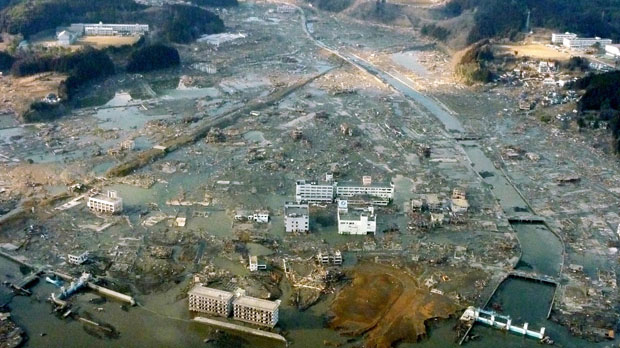Inside Minamisanriku: ‘some kind of Armageddon’
 Alex Thomson
Chief Correspondent
Alex Thomson
Chief Correspondent
Alex Thomson reports from the Japanese port town of Minamisanriku, devastated by the tsunami. Around 10,000 of its people are feared dead – and yet survivors are surprised to see foreign help arrive.
There’s nothing gradual about a massive tsunami in any sense of the word. You may think that the roads to Minamisanriku winds through gradually thickening earthquake damage.
But in fact nothing could be further than the truth – you simply wind round one wooded ravine and there it is: look one way and it is some kind of Armageddon – look the other way and there’s a man tending flowers in his garden and a sign flashing neon, for that Japanese fashion, ten pin bowling.
But it’s clear walking forwards that few if any outsiders have reached what used to be a charming resort on this coastline of deep, wooded, islands and mountainous inlets.
To make that walk would surely arouse in anyone the sense of being in a latter day Hiroshima.
Famed for something else now – it is true. Local people have it that around 10,000 of Minamisanriku’s 17,000 inhabitants are now missing and are presumed dead.
You cross the police tape, you ignore the police officer saying “no media” and you can walk on and on down to the pulverised port, a distance of well over three miles.

To make that walk would surely arouse in anyone the sense of being in a latter day Hiroshima.
I do not make that comparison of course in any other way save this: a landscape flattened and annihilated except for a telecoms building here, or the high school there.
And it is in that high school that extraordinary things are happening.
One of the town’s restaurateurs, Yuchida Takumi, all hennaed hair and large earrings, is carefully bagging and tagging dead bodies in a building behind the school gym.
“I have no restaurant any more, you see?” he asks us, “If you go down there now and look at where it was, all you will see is the concrete base.”
For now, perhaps, there is some sort of therapy to be had in tending to the bureaucracy of death. Bodies mean paperwork – even here. But it is poignant stuff, this is a very small town, and people like Yuchida will likely know or know of the person they are wrapping up in the bright blue polythene bag.
Across at the school base ball field a Japanese Defence Force Chinook helicopter comes and goes all afternoon. Because the hospital is gone you see? So any serious cases must be flown out.
In Pictures – Japan tsunami and earthquake photo gallery

Click on the image to see more photos from Japan
They’re doing what they can, pulling together and their pleasure in seeing outsiders here for the first time, genuinely touching. A woman emerges from the sports hall, where she and her family are living, looks at us in amazement:
“I am so happy you’ve come. Are people in England interested in this?
“I am astonished. I am so pleased. I cannot believe you have come all this way.”
And it’s too much. She wells up. Voice choking, and hugs our translator. By now also in tears.
“I am astonished. I am so pleased. I cannot believe you have come all this way.”
Some moments later, the schools charming English teacher Schinja Saki is standing with us looking down on the rubble filled valley that was his town:
“You know, I look at that and I see again the man I saw on Friday.
“He was on his roof. His whole house was floating past me, I looked at him.
“I shouted. But there was nothing I could do.”
What can you do? A squeeze of the arm, a pat on the back, reassurance that he is doing good things co-ordinating help for a townspeople without a town.
Google images: before and after the tsunami
Google has posted satellite images online showing various places in Japan before and after the tsunami struck. You can see them below.
Your browser does not support iframes. You could try and view the content directly